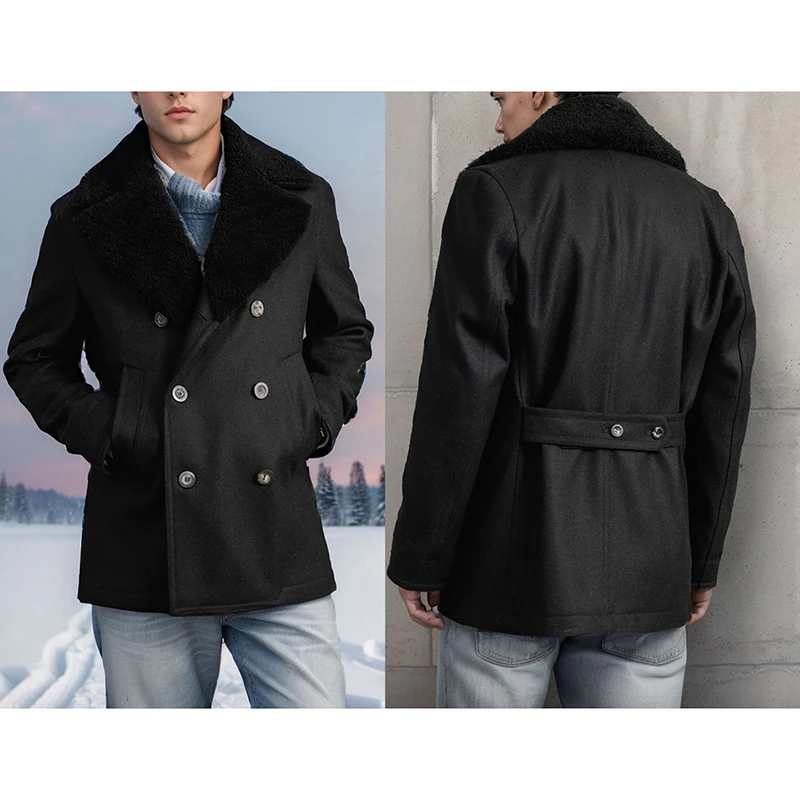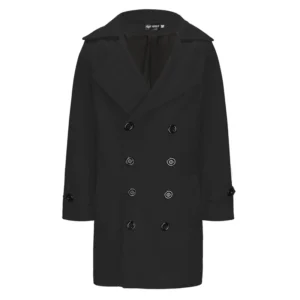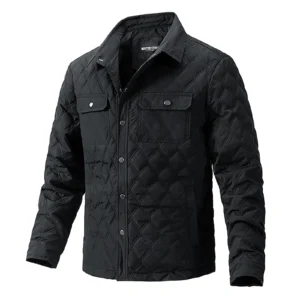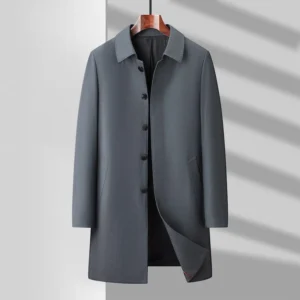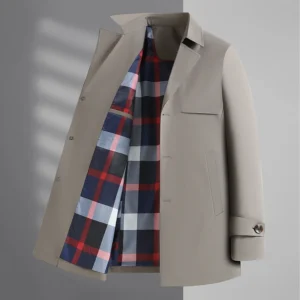Comparing Wool Car Coats and Pea Coats: Key Differences at a Glance
| Feature | Wool Car Coat | Pea Coat |
|---|---|---|
| Origin | Early 20th century automotive culture | Naval maritime wear (17th-18th century) |
| Length | Mid-thigh to knee (32-38 inches) | Hip to mid-thigh (24-32 inches) |
| Cut/Silhouette | Straight or slightly A-line, roomier | Fitted, structured, tapered waist |
| Closure | Single-breasted, often hidden placket | Double-breasted with 6-8 buttons |
| Collar | Straight, spread, or funnel neck | Wide lapels, turn-down collar |
| Formality | Business casual to semi-formal | Smart casual to business casual |
| Signature Features | Longer length, clean lines, practical pockets | Naval buttons, double-breasted front, broad collar |
These fundamental differences directly impact how these classic coats function in a man’s wardrobe. Car coats typically offer more coverage and room for layering, making them practical for various situations, while pea coats deliver a more fitted, maritime-inspired silhouette that emphasizes the chest and shoulders. Understanding these distinctions helps determine which coat will best serve your particular lifestyle needs and style preferences.
Many men find that comprehensive ultimate guides to wool car coats provide valuable insights when comparing these two classic outerwear pieces. For those already leaning toward the car coat’s versatile design, exploring quality men’s wool car coat collections can provide real-world examples of the features we’ll discuss.
The Rich Heritage of Men’s Wool Outerwear
Classic wool outerwear stands as a cornerstone of men’s fashion, representing a perfect marriage of function and style that has endured for centuries. Both car coats and pea coats embody this tradition, each emerging from distinct practical needs yet evolving into timeless wardrobe staples.
Wool’s natural insulation properties made it the material of choice long before synthetic alternatives existed. Its ability to retain warmth even when damp, coupled with incredible durability, established wool as the premier fabric for outerwear designed to withstand harsh elements. This practical heritage continues to influence modern iterations of both coat styles, with each maintaining core elements that reflect their origins while incorporating contemporary touches.
The enduring appeal of these classic wool coats speaks to their authentic design heritage—car coats evolved from practical motoring needs, while pea coats emerged from naval necessity. Understanding this rich background helps appreciate why these styles have transcended fleeting fashion trends to become essential elements in sophisticated men’s wardrobes.
Understanding what defines a wool car coat provides important context for appreciating the distinct characteristics of each style and making an informed choice between them.
Wool Car Coats: Origin and Evolution
The car coat emerged in the early 20th century as a direct response to the automotive revolution. Early automobiles featured open cockpits that exposed drivers to harsh elements, creating demand for specialized outerwear. These original car coats were designed with specific practical features: longer length to protect the legs while seated, durable materials to withstand exposure, and functional closures that wouldn’t interfere with driving.
As automobiles evolved to include enclosed cabins, the car coat transitioned from pure utility to a style statement. The mid-century period saw car coats adopt cleaner lines and more refined silhouettes while maintaining their practical heritage. The straight cut and mid-thigh to knee length remained, but designers began experimenting with more sophisticated fabrics and details.
By the late 20th century, the car coat had fully established itself as a versatile piece of outerwear that bridged the gap between casual and formal. Modern iterations maintain the coat’s utilitarian roots while incorporating contemporary tailoring techniques and materials. Today’s car coats offer the perfect balance of function and style, making them ideal for the modern man navigating varied environments and dress codes.
This evolution from purely practical garment to sophisticated style staple makes men’s car coats particularly versatile in today’s wardrobe, offering flexibility that few other outerwear pieces can match.
Defining Features of the Wool Car Coat
The wool car coat’s distinct characteristics set it apart from other outerwear options:
Mid-thigh to knee length – This specific length provides substantial coverage while seated (original automotive purpose) while allowing ease of movement. The longer cut offers greater protection against cold and wind compared to shorter jackets.
Straight or A-line silhouette – The clean, unfitted cut allows comfortable layering over suits or heavier clothing. This relaxed shape prioritizes functionality and movement, unlike more restrictive fitted coats.
Collar variations – Car coats typically feature either straight collars that can be flipped up for neck protection, spread collars for a more formal look, or funnel necks that provide maximum coverage in harsh conditions.
Closure styles – Traditional button fronts remain popular, though many modern versions incorporate hidden plackets for cleaner lines. Some contemporary designs include zip closures with button overlays, combining security with classic aesthetics.
Practical pocket designs – Functional storage is a hallmark feature, with most car coats offering flap or welt pockets positioned for easy access. Many include interior pockets specifically designed for valuables or personal items.
These defining elements combine to create a coat that balances practical warmth with refined style, making it appropriate for various settings from business commutes to weekend outings.
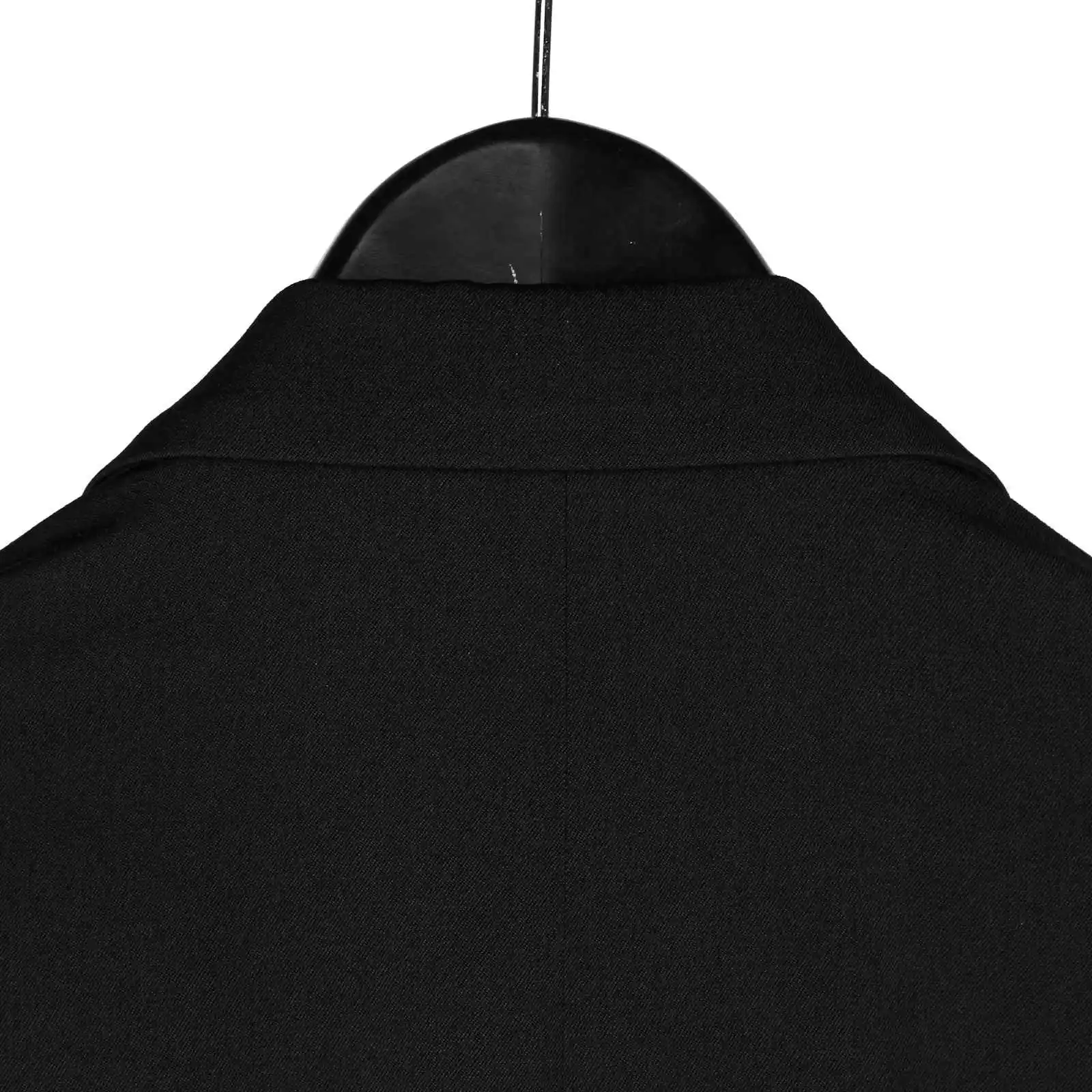
Many style-conscious men appreciate the unmatched benefits of wool car coats for their versatility across different dress codes and weather conditions.
Pea Coats: Naval Heritage and Classic Design
The pea coat’s origins trace back to European naval forces, with early versions appearing in the Dutch Navy during the 1700s. These initial designs featured heavy wool construction to protect sailors from punishing maritime conditions. The coat quickly spread to other naval forces, with British and American navies adopting their own variations by the 19th century.
Military functionality dictated the pea coat’s distinctive features. The short, double-breasted design allowed for freedom of movement on deck while the high collar provided protection against biting winds. Dense, water-resistant wool (often 20-32 ounce melton) offered remarkable insulation even in damp conditions. Naval functionality extended to details like large buttons that could be manipulated while wearing gloves and vertical pockets that prevented items from falling out during ship maneuvers.
Following World War II, surplus military pea coats entered civilian fashion, where their distinctive silhouette and practical warmth gained popularity. The transition from uniform to fashion statement was complete by the mid-20th century, with designers embracing and refining the classic naval design. Today’s pea coats maintain their maritime heritage while incorporating modern tailoring and materials, continuing a design legacy spanning several centuries.
For those seeking authentic maritime style, Metro Cloak’s men’s pea coat collection preserves these classic design elements while incorporating modern comfort and craftsmanship.
Signature Elements of the Classic Pea Coat
The pea coat’s distinctive profile comes from several key design elements:
Double-breasted front – This defining feature provides superior wind protection with overlapping fabric layers across the chest. Traditionally featuring 6-8 buttons arranged in parallel vertical rows, this design creates the coat’s distinctive silhouette.
Broad lapels and collar – The wide, convertible collar can be worn folded down for a smart look or flipped up to protect the neck in harsh weather. This versatile feature combines practical function with distinctive style.
Traditional button details – Authentic pea coats feature large buttons, historically made from wood, bone, or metal. Naval versions often included anchors or emblems, while modern interpretations may use horn, corozo, or synthetic materials while maintaining the traditional size.
Strategic pocket placement – Vertical or slanted hand-warmer pockets positioned for accessibility while maintaining the clean silhouette. Many traditional designs feature additional interior pockets for valuables.
Fitted silhouette – Unlike many winter coats, pea coats feature a tailored cut that tapers at the waist, creating a masculine V-shape that flatters most body types while still allowing room for light layering.
These elements combine to create the pea coat’s immediately recognizable profile—a testament to how function-driven military design has influenced enduring civilian fashion.
The double-breasted pea coat remains particularly popular for its classic naval appearance and exceptional wind protection in cold conditions.
Material Matters: Wool Quality and Construction
The performance of both car coats and pea coats heavily depends on their wool quality and construction methods. Traditional pea coats typically use heavier Melton wool (24-32 oz weight), providing exceptional warmth and wind resistance. This dense, fulled wool creates a nearly weatherproof shell that naval personnel relied upon. Car coats often employ slightly lighter wool (20-24 oz) for greater versatility across seasons.
Quality wool outerwear should contain high percentages of virgin wool, which offers superior insulation thanks to natural crimping in the fibers that traps warm air. Premium options might include merino or lambswool for increased softness without sacrificing performance. The finest examples feature fabric with higher “S-numbers” (a measure of fiber fineness), indicating softer, more luxurious material.
Construction techniques significantly impact performance and longevity. Superior wool coats feature fully-lined bodies with sturdy interior structures. Quality indicators include taped seams, reinforced stress points, and hand-sewn details in critical areas. Better coats incorporate interlining or canvas between wool and lining layers, providing structure and improving insulation.
Modern wool blends often incorporate small percentages of synthetic fibers (5-10% nylon or polyester) or natural additions like cashmere to enhance specific properties without compromising wool’s natural benefits. These thoughtful blends can improve durability, reduce weight, or add water resistance while maintaining the classic wool appearance and performance.
When evaluating options, many experts recommend considering whether an 100 percent wool coat provides the optimal balance of tradition and performance for your specific needs.
Warmth, Weather Protection and Practicality
When comparing these classic coats for performance, several factors deserve consideration. Traditional pea coats generally offer superior insulation in extreme cold due to their denser wool construction and double-breasted overlap that eliminates drafts. The shorter length, however, leaves more of the lower body exposed. Car coats provide more comprehensive coverage with their extended length, though typically with slightly less intense insulation at the core.
Wind resistance varies significantly between styles. The pea coat’s double-breasted closure creates an effective barrier against gusting winds, particularly when the collar is turned up. Car coats with single-breasted closures may allow more air penetration unless they feature additional elements like hidden plackets or storm flaps.
For everyday practicality, car coats typically offer greater mobility due to their straighter cut and roomier fit, making them ideal for commuting and daily activities. Their longer length provides better protection when sitting outdoors or exiting vehicles. Pea coats, with their more fitted silhouette, may restrict movement slightly but offer a more streamlined profile that some find preferable for urban environments.
Both coat styles require similar maintenance, with periodic professional cleaning recommended to preserve the wool’s natural properties. The more substantial construction of traditional pea coats may give them a slight edge in long-term durability, though a quality car coat from a reputable manufacturer should provide many years of service.
Understanding whether a wool coat will keep you warm in your specific climate conditions helps determine which style might better serve your practical needs.
Style Versatility and Formality Spectrum
On the formality spectrum, wool car coats and pea coats occupy slightly different positions that influence their versatility in various settings. Car coats generally range from business casual to semi-formal, with their longer length and cleaner lines making them appropriate companions for everything from suits to smart casual attire. The streamlined silhouette particularly complements business wear without the formality of a full-length overcoat.
Pea coats typically fall within the smart casual to business casual range. Their military heritage and shorter length create a more casual foundation, though premium versions in dark colors can certainly elevate business casual ensembles. The distinctive double-breasted front projects confidence but maintains a slightly more casual appearance than single-breasted alternatives.
For business settings, a car coat in charcoal, navy, or camel pairs seamlessly with suits or dress trousers and button-downs. The clean lines maintain professional appearance while providing practical warmth. Pea coats work well with business casual attire—think oxford shirts, knit ties, and wool trousers—creating a sharp look with historical character.
In casual contexts, both coat styles shine with different aesthetics. Car coats create a refined casual look when paired with dark denim, chelsea boots, and fine gauge sweaters. Pea coats excel in rugged casual combinations: think selvedge denim, work boots, and chunky knitwear that complement their maritime heritage.
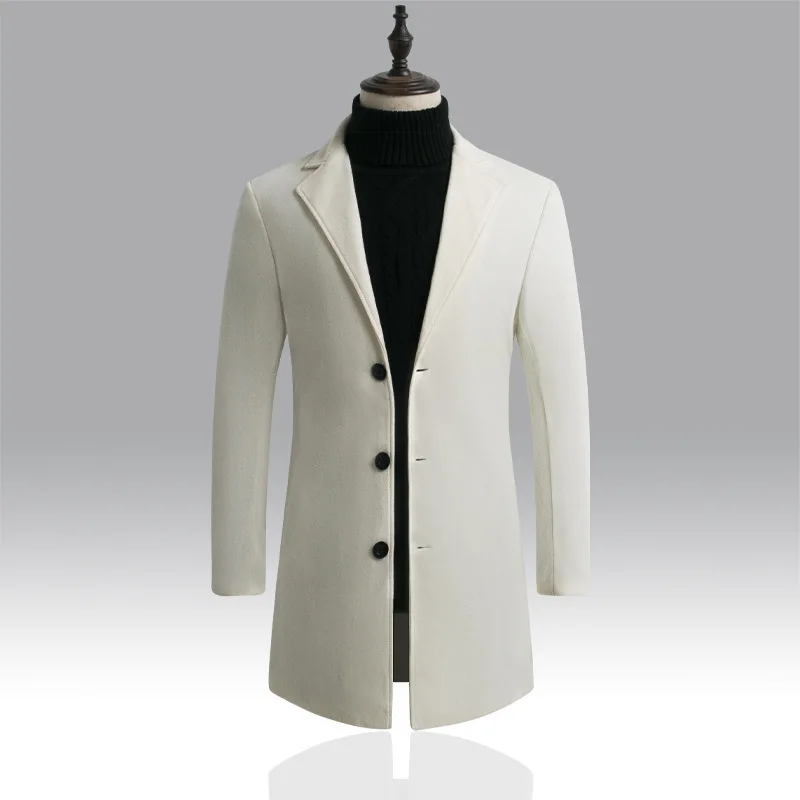
Understanding how to wear a wool car coat effectively across different settings maximizes its versatility in your wardrobe.
Body Types and Fit Considerations
Different body types benefit from specific coat styles that enhance natural proportions. For taller men (over 6‘2”), car coats provide balanced coverage without appearing short, while pea coats may appear proportionally smaller unless specifically designed with extended length. Conversely, shorter men (under 5‘8”) often find pea coats’ shorter length creates better proportion, while car coats may need tailoring to avoid overwhelming the frame.
Men with broader shoulders and chest measurements typically find pea coats particularly flattering, as the double-breasted design accentuates this V-shaped physique. The structured shoulders and tapered waist create a classic masculine silhouette. Slimmer builds may find car coats offer a cleaner line that doesn’t emphasize narrow shoulders, though tailored pea coats can also work well when properly fitted.
For larger builds, car coats often provide more comfortable fit with their straighter cut and single-breasted closure, avoiding the potential bulk that double-breasted styles might add. Look for styles with subtle A-line shaping rather than extremely fitted cuts. Larger men can certainly wear pea coats but should seek versions cut with sufficient room across the shoulders and chest to accommodate comfortable movement.
Regardless of body type, proper sleeve length remains crucial—sleeves should reach just to the base of the thumb when arms are relaxed. Shoulders should align with your natural shoulder edge, and when buttoned, the coat should allow comfortable movement without excessive fabric or tightness.
Understanding the difference between classic fit versus slim fit pea coats helps ensure you select the most flattering option for your build.
Styling Guide: Mastering the Car Coat Look
Creating versatile looks with a car coat begins with understanding its refined yet relaxed character. For business settings, pair a charcoal or navy car coat with tailored trousers, a fine merino sweater, and leather dress boots. This combination balances professionalism with practical warmth. Add a cashmere scarf in a complementary tone to enhance sophistication while providing additional neck protection.
For elevated casual occasions, combine a camel or olive car coat with dark selvedge denim, a light turtleneck, and suede chukka boots. This approach creates a sophisticated weekend look that works for everything from gallery visits to dinner outings. The car coat’s clean lines provide structure without appearing overly formal.
Layering works particularly well with car coats due to their roomier cut. Try incorporating a lightweight quilted vest between your shirt and coat for added warmth without bulk. This technique creates visual interest while enhancing insulation during colder months. For accessories, leather gloves and a simple wool beanie complete the practical yet refined aesthetic.
Color coordination follows simple principles: neutral car coats (navy, charcoal, camel) pair easily with most wardrobes, while bolder colors like burgundy or forest green work best when anchored with neutral supporting pieces. The coat’s substantial presence means it should generally be the focal point of your outfit, with complementary—rather than competing—elements.
For more inspiration, exploring stylish wool car coat outfits for men provides practical combinations for various settings and personal styles.
Styling Guide: Perfecting the Pea Coat Aesthetic
The pea coat’s naval heritage provides a strong foundation for creating distinctive outfits that balance rugged and refined elements. For a classic approach, pair a navy pea coat with cream fisherman’s sweater, selvedge denim, and moc-toe boots—a combination that honors maritime origins while creating a timeless casual look. A simple wool watch cap completes this heritage-inspired ensemble.
For smart-casual settings, combine a dark pea coat with tailored chinos, a light blue oxford button-down, and suede derby shoes. This creates a sophisticated yet approachable look suitable for dates or casual Friday office environments. A patterned scarf adds visual interest while enhancing the coat’s nautical character.
Layering requires thoughtful consideration with pea coats due to their more fitted silhouette. Focus on thinner, high-insulation middle layers like fine merino sweaters or lightweight technical garments rather than bulky knits that might distort the coat’s clean lines. Quarter-zip pullovers work particularly well under pea coats, providing warmth without collar competition.
Accessorizing effectively means embracing complementary pieces with similar heritage appeal. Consider leather gloves with knuckle detailing, wool scarves in burgundy or forest green, and simple beanies in navy or charcoal. These elements enhance the coat’s traditional character without overcomplicating the look.
Understanding traditional pea coat styling helps maintain authentic character while adapting this classic piece for contemporary wardrobes.
Which Coat for Which Occasion?
Different scenarios call for different coat characteristics, making certain styles more appropriate for specific situations. For daily business commuting, car coats typically offer practical advantages—their longer length provides better protection when sitting in vehicles or public transportation, while their roomier cut accommodates suits without wrinkling. The clean lines maintain professional appearance throughout the workday.
Pea coats excel in urban casual settings where their compact profile allows easier navigation through crowds and confined spaces. The distinctive silhouette creates a sharper casual impression that works well for social outings, weekend activities, and casual dining. Their fitted nature makes them particularly suitable when outerwear style is a primary consideration.
Climate considerations significantly impact which coat serves better. In moderate winter climates (temperatures around 35-45°F), both styles provide adequate protection, especially with appropriate layering. For severe cold (below 25°F), pea coats offer superior core warmth through their double-breasted construction, though their shorter length leaves more of the body exposed. Car coats provide more comprehensive coverage but might require additional layers in extreme conditions.
For travel, car coats typically offer greater versatility across different settings and situations, making them ideal companions for business trips or vacations involving various activities and dress codes. Their neutral styling adapts more seamlessly to unfamiliar environments where local fashion customs might differ.
Many men appreciate the distinctive maritime character of wool pea coats for specific occasions while maintaining car coats for broader versatility.
Pros and Cons: The Car Coat Perspective
Advantages of Car Coats:
* Extended coverage protects more of the body from cold and precipitation
* Roomier cut allows comfortable layering over suits and bulkier clothing
* Clean, understated design transitions seamlessly across dress codes
* Single-breasted closure offers quicker on/off convenience
* Greater variety of styling options from casual to semi-formal
Potential Limitations:
* May lack the intense core warmth of double-breasted alternatives
* Longer length can be cumbersome in certain crowded settings
* Some styles may appear overly voluminous without proper tailoring
* Often requires more fabric, potentially increasing weight and cost
* Less distinctive silhouette compared to more recognizable coat styles
The car coat particularly excels for versatile urban lifestyles requiring transitions between various settings and formality levels throughout the day. Its adaptable nature makes it an excellent foundation piece for building a functional cold-weather wardrobe.
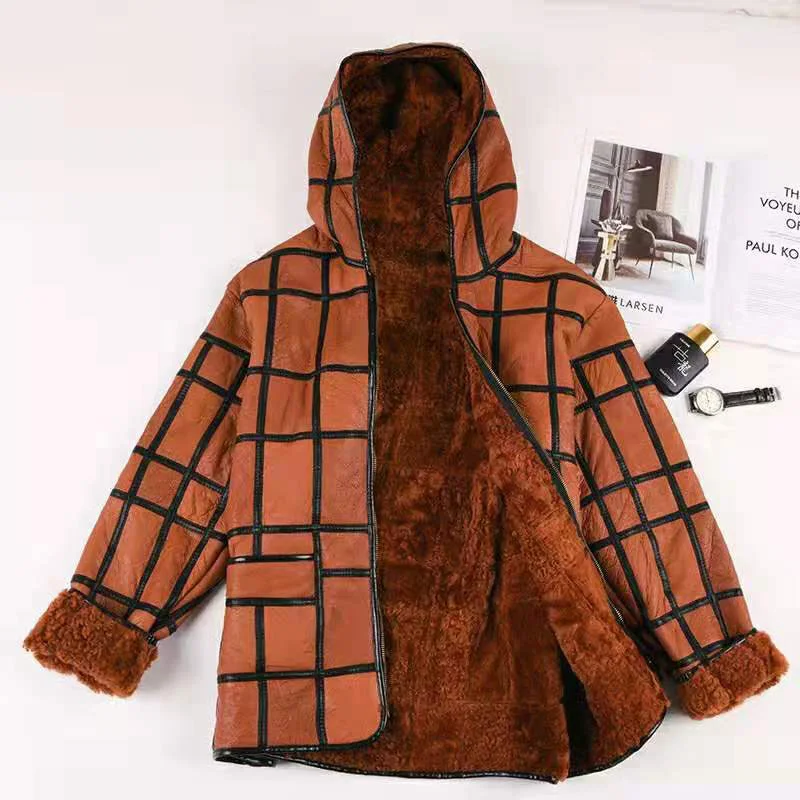
Pros and Cons: The Pea Coat Analysis
Advantages of Pea Coats:
* Double-breasted construction provides superior core warmth
* Distinctive silhouette creates immediate visual impact
* Maritime heritage adds character and authenticity
* Shorter length allows greater mobility in active situations
* Structured fit creates flattering shape for many body types
Potential Limitations:
* Fitted silhouette restricts layering capacity
* Shorter length leaves lower body less protected
* Double-breasted style requires more time to fasten properly
* Naval associations may feel too casual for formal business settings
* Distinctive design less versatile across some dress codes
Pea coats shine particularly in smart-casual environments where their distinctive character adds personality without appearing overly casual. Their combination of practicality and distinctive style makes them especially valuable for weekend and social occasions during colder months.
Understanding effective winter layering with a wool car coat helps maximize its versatility across different temperature ranges and settings.
What Experts Say: Comparing Longevity and Investment Value
Fashion industry professionals frequently note that both coat styles offer excellent investment potential when purchased in quality versions. A well-made wool car coat typically provides 7-10 years of regular wear before showing significant signs of aging, making its higher initial cost more reasonable when calculated on a cost-per-wear basis. The classic design elements ensure it remains stylistically relevant despite fashion trends.
Pea coats often demonstrate even greater longevity, with quality examples frequently lasting 10+ years with proper care. Their substantial construction and classic design have remained essentially unchanged for decades, minimizing style obsolescence. The significant wool content in traditional versions allows for potential repairs and refreshing, extending useful life.
Quality indicators for both styles include high wool percentage (80%+ ideally), full lining with sturdy materials, reinforced stitching at stress points, and attention to details like properly finished buttonholes and interior seams. Investment pieces should feature natural horn or corozo buttons rather than plastic, with hand-finished details where appropriate.
For maximum long-term value, experts recommend selecting conservative colors (navy, charcoal, camel) rather than trend-driven options. These versatile shades maintain relevance while showing less obvious wear over time. Higher initial investment in premium versions typically yields better longevity through superior materials and construction methods.
Exploring options among best wool car coats for men helps identify quality features worth the investment for long-term value.
Making Your Decision: Which Coat Suits Your Lifestyle?
Selecting between these classic coat styles requires honest assessment of your specific needs and preferences. Consider these key decision factors:
Primary usage context – Where will you wear this coat most often? Business settings generally favor car coats, while varied casual settings might benefit from a pea coat’s distinctive character.
Existing wardrobe compatibility – Which coat better complements your current clothing? Car coats pair seamlessly with both formal and casual wardrobes, while pea coats create stronger statements with casual and smart-casual attire.
Climate considerations – How severe are your typical winter conditions? Extended subfreezing periods might benefit from a pea coat’s intense core warmth, while variable conditions favor the car coat’s adaptable nature.
Personal body type – Which silhouette flatters your frame? Broader builds often benefit from pea coats’ structured shape, while taller or slimmer frames may find car coats more proportional.
Style preference – Do you favor understated versatility or distinctive character? Car coats provide refined versatility, while pea coats offer bold maritime heritage.
This assessment framework helps determine which coat will deliver better value for your specific situation. Remember that the best investment is one that addresses your actual needs rather than theoretical versatility.
Mens Double Breasted Pea Coat, Mens Wool Blend Coat, Mens Wool Pea Coat
Price range: $136.84 through $157.36 Select options This product has multiple variants. The options may be chosen on the product pageMens Double Breasted Pea Coat, Mens Hooded Winter Coat, Mens Quilted Coat
Price range: $81.00 through $108.48 Select options This product has multiple variants. The options may be chosen on the product page- Price range: $177.52 through $182.44 Select options This product has multiple variants. The options may be chosen on the product page
Mens Dress Coat, Mens Topcoats, Mens Wool Car Coat
Price range: $231.88 through $233.77 Select options This product has multiple variants. The options may be chosen on the product pageMens Long Overcoat, Mens Topcoats, Mens Wool Car Coat
$184.36 Select options This product has multiple variants. The options may be chosen on the product pageMens Tweed Coat, Mens Wool Blend Coat, Mens Wool Car Coat
Price range: $104.44 through $156.12 Select options This product has multiple variants. The options may be chosen on the product page
Can You Own Both? Creating a Versatile Outerwear Collection
Many style enthusiasts find that car coats and pea coats serve complementary roles in a complete wardrobe. Rather than choosing between them, consider how they might work together to address different scenarios in your lifestyle. A thoughtful two-coat strategy might include a car coat in a versatile neutral tone for business and formal occasions, paired with a pea coat in a different color for weekend and casual settings.
When building this dual collection, strategic color selection prevents redundancy. For example, a charcoal car coat paired with a navy pea coat provides maximum versatility across different outfits and settings. Alternatively, a navy car coat and a camel or gray pea coat creates a similarly versatile pairing with distinct visual identities.
For those beginning their quality outerwear collection, most experts recommend acquiring the coat that addresses your most frequent needs first. Business professionals might prioritize the car coat’s versatility, while those with casual lifestyles might begin with the pea coat’s distinctive character. The second piece can follow as budget allows, completing a comprehensive approach to cold-weather dressing.
This strategic approach to collection building maximizes the utility of your outerwear investment while providing appropriate options for the full spectrum of life’s activities.
Frequently Asked Questions: Car Coats vs. Pea Coats
Can pea coats be worn with formal business attire?
While traditional pea coats are generally considered too casual for formal business settings, premium versions in dark colors can work with business casual attire. For formal business environments, car coats typically provide more appropriate styling.
Which coat style is warmer?
Traditional pea coats often provide greater core warmth due to their double-breasted construction and dense wool. However, car coats offer better full-body coverage with their extended length, creating different warmth profiles.
What defines a car coat versus other coat styles?
Car coats are distinguished by their mid-thigh to knee length, straight or slight A-line cut, and practical design elements originally intended for early motorists. Their length is longer than jackets but shorter than full overcoats.
Can both styles work for casual weekend wear?
Absolutely. Pea coats naturally excel in casual settings due to their maritime heritage, while car coats can be styled down effectively with jeans and casual footwear for refined weekend looks.
Are wool blends acceptable in quality versions of these coats?
Yes, quality wool blends (typically 80% wool with small percentages of synthetic fibers or cashmere) can offer improved performance characteristics while maintaining the classic appearance and insulation properties of traditional wool.
Which coat style is more timeless?
Both styles have demonstrated remarkable longevity in men’s fashion. Pea coats have remained essentially unchanged for over a century, while car coats have evolved slightly more to accommodate changing transportation and lifestyle needs.

